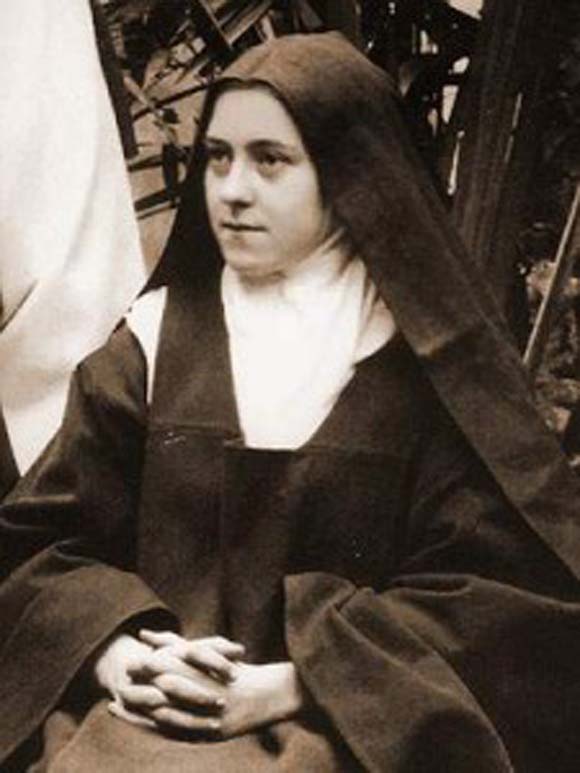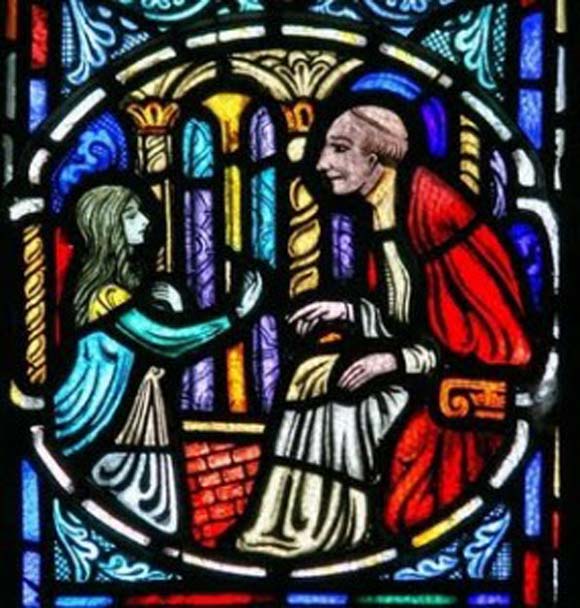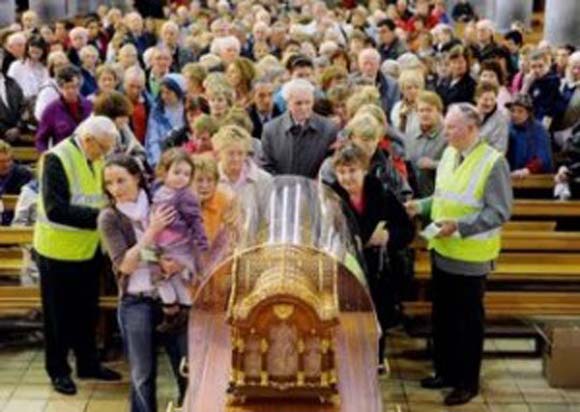
Saints This Month-1 October: St. Therese of Lisieux
 Little flower? She was as tough as old boots! – Fr Denis Geraghty OP, Lourdes 2009
Little flower? She was as tough as old boots! – Fr Denis Geraghty OP, Lourdes 2009
As Oxford prepares to welcome the relics of St. Therese of Lisieux, it is a perfect time to reflect on her life and message. She was born in Normandy in 1873, to devout parents, both of whom have been beatified. Her mother died when she was four and her father sold his lace business to a nephew and relocated the family to Lisieux. Therese experienced another loss at the age of nine when her “second mother”, her sister Pauline, entered the local Carmelite monastery.
A few months after this the child Therese took ill with fever. As the family stood around the sick-bed, looking at her like a “string of onions”, Therese focused on the statue of Mary in her room and prayed to her. She saw the statue smile at her and was healed. After her recovery she developed a great habit of mental prayer, finding places of solitude and quiet to listen and speak to God. However she was still prone to wild emotional tantrums and would often burst into tears at the slightest negativity. However at Christmas 1886 , just as such an outburst was bubbling inside her, she felt Jesus enter her heart. This conversion, as she called it, gave her a greater understanding of others and herself. The following Christmas she would enter Carmel.
Whilst she is affectionately know as the Little Flower,  over the following year she displayed a will of steel and the toughness of old boots. The superior of the Carmelite Convent said she was too young to enter. Therese went to the Bishop who concurred with the Mother Superior. Therese became very depressed and her father tried to cheer her spirits by taking her and her sister Celine on pilgrimage to Rome. Therese enjoyed the experience tremendously. Her small stature and youth were an advantage as she could touch tombs and relics without being shouted at. The highlight of the trip was an audience with Pope Leo XIII. As the childish girl from Normandy came close to the Vicar of Christ she broke all protocol of the Papal Court and begged the Holy Father to allow her to enter the Carmel in Liseux. The Pope replied, and Therese was carried away by two guards. However the Vicar General was impressed with her determination and she was accepted for early entry into the convent.
over the following year she displayed a will of steel and the toughness of old boots. The superior of the Carmelite Convent said she was too young to enter. Therese went to the Bishop who concurred with the Mother Superior. Therese became very depressed and her father tried to cheer her spirits by taking her and her sister Celine on pilgrimage to Rome. Therese enjoyed the experience tremendously. Her small stature and youth were an advantage as she could touch tombs and relics without being shouted at. The highlight of the trip was an audience with Pope Leo XIII. As the childish girl from Normandy came close to the Vicar of Christ she broke all protocol of the Papal Court and begged the Holy Father to allow her to enter the Carmel in Liseux. The Pope replied, and Therese was carried away by two guards. However the Vicar General was impressed with her determination and she was accepted for early entry into the convent.
During her first years in the convent she experienced much suffering. Her father had a stroke and became very ill. Gossip filtered into the convent about his sanity and Therese was filled with guilt believing that her entry was responsible for his malady. She also experienced dryness in prayer, saying that she was so grief-stricken that she often fell asleep in prayer. She consoled herself by saying that mothers loved children when they lie asleep in their arms and so God must love her when she slept during prayer.
She knew that as a Carmelite nun she would never be able to perform great deeds. “Love proves itself by deeds, so how am I to show my love? Great deeds are forbidden me. The only way I can prove my love is by scattering flowers and these flowers are every little sacrifice, every glance and word, and the doing of the least actions for love.” She took every chance to sacrifice, no matter how small it would seem. She smiled at the sisters she didn’t like. She ate everything she was given without complaining — so that she was often given the worst leftovers. One time she was accused of breaking a vase when she was not at fault. Instead of arguing she sank to her knees and begged forgiveness. These little sacrifices cost her more than bigger ones, for these went unrecognised by others. No one told her how wonderful she was for these little secret humiliations and good deeds.
In 1896 she began to cough blood. She kept working without telling anyone until she became so sick a year later that it was obvious. Worst of all she had lost her joy and confidence and felt she would die young without leaving anything behind. Pauline had already had her writing down her memories for a journal so they would have something to circulate on her life after her death. Her pain was so great but her one dream was of the work she would do after her death, helping those on earth. “I will return,” she said, “my heaven will be spent on earth.” She died on September 30, 1897 at the age of 24. She was canonized 28 years later and in 1997 she was declared a Doctor of the Church.
Her influence is still very much present. Her “Little Way” is an inspiration for millions of people. She expresses how traditionally great deeds and heroic acts are not the only way to sanctity. She gives an example of the spiritual life that is understandable and imitable by all, regardless of education or sophistication. St. Therese always wanted to travel the world as a missionary and in a way she does. Her relics have been taken around the globe! Their presence has not only deepened the faith of Catholics but has helped people of all denominations and religions, as their stopover in York Minster showed.
St. Therese realised that one does not need to found a religious order or suffer martyrdom to know and love Christ. She realised that love is the calling of all Christians and to love truly is always a great deed: “I feel in me the vocation of the Priest. I have the vocation of the Apostle. Martyrdom was the dream of my youth and this dream has grown with me. Considering the mystical body of the Church, I desired to see myself in them all. Charity gave me the key to my vocation. I understood that the Church had a Heart and that this Heart was burning with love. I understood that Love comprised all vocations, that Love was everything, that it embraced all times and places … in a word, that it was eternal! Then in the excess of my delirious joy, I cried out: O Jesus, my Love … my vocation, at last I have found it … My vocation is Love!”
The Dominican Friars will be leading Compline at the Oxford Oratory in the presence of St. Therese’s relics on the 7th of October at 11:45. For more information click here.


